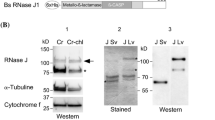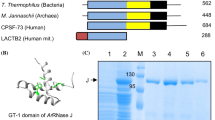Abstract
The 3′ ends of chloroplast mRNAs are produced by the processing of longer precursors. The 3′ ends of most plastid mRNAs are located at, or several nucleotides downstream of, stem-loop structures, which act as 3′-end-processing signals and RNA stability elements. In chloroplasts of the green alga Chlamydomonas reinhardtii, 3′-end maturation of atpB mRNA involves endonucleolytic cleavage of the pre-mRNA at an AU-rich site located about 10 nucleotides downstream of the stem-loop structure. This cleavage is followed by exonucleolytic resection to generate the mature 3′ end. In order to define critical nucleotides of the endonucleolytic cleavage site, we mutated its sequence. Incubation of synthetic atpB pre-RNAs containing these mutations in a chloroplast protein extract resulted in the accumulation of 3′-end-processed products. However, in two cases where the AU-rich sequence of this site was replaced with a GC-rich one, the 3′ end of the stable processing product differed from that of the wild-type product. To examine whether these mutations affected atpB mRNA processing or accumulation in vivo, the endogenous 3′ UTR was replaced with mutated sequences by biolistic transformation of Chlamydomonas chloroplasts. Analysis of the resulting strains revealed that the accumulation of atpB mRNA was approximately equal to that of wild-type cells, and that a wild-type atpB 3′ end was generated. These results imply that Chlamydomonas atpB 3′ processing parallels the situation with other endonucleases such as Escherichia coli RNAse E, where specific sequences are required for correct in vitro processing, but in vivo these mutations can be overcome.
Similar content being viewed by others
References
Barkan, A. 1988. Proteins encoded by a complex chloroplast transcription unit are each translated from both monocistronic and polycistronic RNAs. EMBO J. 7: 2637–2644.
Blowers, A.D., Klein, U., Ellmore, G.S. and Bogorad, L. 1993. Functional in vivo analyses of the 3? flanking sequences of the Chlamydomonas chloroplast rbcL and psaB genes. Mol. Gen. Genet. 238: 339–349.
Chen, H. and Stern, D.B. 1991. Specific ribonuclease activities in spinach chloroplasts promote mRNA maturation and degradation. J. Biol. Chem. 266: 242-5–24211.
Cohen, S. and McDowall, K. 1997. RNase E: still a wonderfully mysterious enzyme. Mol. Microbiol. 23: 1-99–11-6.
Drager, R.G. and Stern, D.B. 1998. Chloroplast RNA synthesis and processing. In: J.-D. Rochaix, M. Goldschmidt-Clermont and S. Merchant (Eds.), Molecular Biology of Chlamydomonas: Chloroplasts and Mitochondria. Kluwer Academic Publishers, Dordrecht, Netherlands, pp. 125–14-.
Drager, R.G., Zeidler, M., Simpson, C.L. and Stern, D.B. 1996. A chloroplast transcript lacking the 3? inverted repeat is degraded by 3??5? exoribonuclease activity. RNA 2: 652–663.
Drager, R.G., Girard-Bascou, J., Choquet, Y., Kindle, K.L. and Stern, D.B. 1998. In vivo evidence for 5? to 3? exoribonuclease degradation of an unstable chloroplast mRNA. Plant J. 13: 85–96.
Ehretsmann, C.P., Carpousis, A.J. and Krisch, H.M. 1992. Speci-ficity of Escherichia coli endoribonuclease RNase E: in vivo and in vitro analysis of mutants in a bacteriophage T4 mRNA processing site. Genes Dev. 6: 149–159.
Gruissem, W. and Schuster, G. 1993. Control of mRNA degradation in organelles. In: G. Brawerman and J. Belasco (Eds.), Control of Messenger RNA Stability. Academic Press, Orlando, FL, pp. 329–365.
Hayes, R., Kudla, J., Schuster, G., Gabay, L., Maliga, P. and Gruissem, W. 1996. Chloroplast mRNA 3?-end processing by a high molecular weight protein complex is regulated by nuclear encoded RNA binding proteins. EMBO J. 15: 1132–1141.
Kudla, J., Hayes, R. and Gruissem, W. 1996. Polyadenylation accelerates degradation of chloroplast mRNA. EMBO J. 15: 7137–7146.
Lisitsky, I. and Schuster, G. 1995. Phosphorylation of a chloroplast RNA-binding protein changes the affinity to RNA. Nucl. Acids Res. 23: 2506–2511.
Lisitsky, I., Liveanu, V. and Schuster, G. 1995. RNA-binding characteristics of a ribonucleoprotein from spinach chloroplast. Plant Physiol. 107: 933–941.
Lisitsky, I., Klaff, P. and Schuster, G. 1996. Addition of poly(A)-rich sequences to endonucleolytic cleavage sites in the degradation of spinach chloroplast mRNA. Proc. Natl. Acad. Sci. USA 93: 13398–13403.
Lisitsky, I., Kotler, A. and Schuster, G. 1997. The mechanism of preferential degradation of polyadenylated RNA in the chloroplast: the exoribonuclease 100RNP/PNPase displays high bind686 ing affinity for poly(A) sequence. J. Biol. Chem. 272: 17648–17653.
Mackie, G.A. 1998. Ribonuclease E is a 5?-end-dependent endonuclease. Nature 395: 720–723.
Mott, J.E., Galloway, J.L. and Platt, T. 1985. Maturation of Escherichia coli tryptophan operon mRNA: evidence for 3?-exonucleolytic processing after rho-dependent termination. EMBO J. 4: 1887–1891.
Nickelsen, J. and Link, G. 1993. The 54 kDa RNA-binding protein from mustard chloroplasts mediates endonucleolytic transcript 3? end formation in vitro. Plant J. 3: 537–544.
Rott, R., Drager, R.G., Stern, D.B. and Schuster, G. 1996. The 3? untranslated regions of chloroplast genes in Chlamydomonas reinhardtii do not serve as efficient transcriptional terminators. Mol. Gen. Genet. 252: 676–683.
Rott, R., Levy, H., Drager, R., Stern, D. and Schuster, G. 1998a. 3?-processed mRNA is preferentially translated in Chlamydomonas reinhardtii chloroplast. Mol. Cell Biol. 18: 4605–4611.
Rott, R., Liveanu, V., Drager, R.G., Stern, D.B. and Schuster, G. 1988b. The sequence and structure of the 3? untranslated regions of chloroplast transcripts are important determinants of mRNA accumulation and stability. Plant Mol. Biol. 36: 307–314.
Sakamoto, W., Sturm, N.R., Kindle, K.L. and Stern, D.B. 1994. petD mRNA maturation in Chlamydomonas reinhardtii chloroplasts: the role of 5? endonucleolytic processing. Mol. Cell. Biol. 14: 6180–6186.
Schuster, G. and Gruissem, W. 1991. Chloroplast mRNA 3? end processing requires a nuclear-encoded RNA-binding protein. EMBO J. 10: 1493–1502.
Stern, D.B. and Gruissem, W. 1989. Chloroplast mRNA 3? end maturation is biochemically distinct from prokaryotic mRNA processing. Plant Mol. Biol. 13: 615–625 (1989).
Stern, D.B. and Gruissem, W. 1987. Control of plastid gene expression: 3? inverted repeats act as mRNA processing and stabilizing elements, but do not terminate transcription. Cell 51: 1145–1157.
Stern, D.B. and Kindle, K.L. 1993. 3? end maturation of the Chlamydomonas reinhardtii chloroplast atpB mRNA is a twostep process. Mol. Cell. Biol. 13: 2277–2285.
Stern, D.B., Jones, H. and Gruissem, W. 1989. Function of plastid mRNA 3? inverted repeats: RNA stabilization and gene-specific protein binding. J. Biol. Chem. 264: 18742–18750.
Stern, D.B., Radwanski, E.R. and Kindle, K.L. 1991. A 3? stem/loop structure of the Chlamydomonas chloroplast atpB gene regulates mRNA accumulation in vivo. Plant Cell 3: 285–297.
Wahle, E. and Keller, W. 1992. The biochemistry of 3?-end cleavage and polyadenylation of messenger RNA precursors. Annu. Rev. Biochem. 61: 419–440.
Westhoff, P. and Herrmann, R.G. 1988. Complex RNA maturation in chloroplasts: the psbB operon from spinach. Eur. J. Biochem. 171: 551–564.
Woessner, J.P., Gillham, N.W. and Boynton, J.E. 1986. The sequence of the chloroplast atpB gene and its flanking regions in Chlamydomonas reinhardtii. Gene 44: 17–28.
Yang, J. and Stern, D.B. 1997. The spinach chloroplast endoribonuclease CSP41 cleaves the 3?-untranslated region of petD mRNA primarily within its terminal stem-loop structure. J. Biol. Chem. 272: 12874–12880.
Yang, J., Schuster, G. and Stern, D.B. 1996. CSP41, a sequencespecific chloroplast mRNA binding protein, is an endoribonuclease. Plant Cell 8: 1409–1420.
Author information
Authors and Affiliations
Rights and permissions
About this article
Cite this article
Rott, R., Liveanu, V., Drager, R.G. et al. Altering the 3′ UTR endonucleolytic cleavage site of a Chlamydomonas chloroplast mRNA affects 3′-end maturation in vitro but not in vivo. Plant Mol Biol 40, 679–686 (1999). https://doi.org/10.1023/A:1006252201661
Issue Date:
DOI: https://doi.org/10.1023/A:1006252201661




